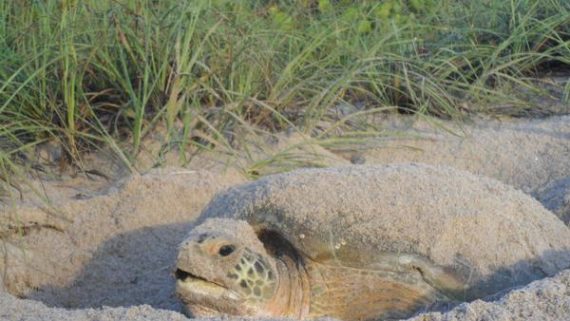The Non-Locals
You may be familiar with the sea turtle species native to the North Carolina coast, including the loggerhead, green, Kemp’s ridley, hawksbill, and leatherback. Yet there are actually two other species: the olive ridley and the flatback. This makes a total of 7 sea turtle species and all are threatened or endangered.

This image from the National Aquarium shows the size comparisons of the seven sea turtle species along with the extinct Archelon
If you live on the western coast of the United States, you might have heard of the olive ridley sea turtle. These sea turtles get their name from their olive green color. Though they nest in the warmer parts of the Pacific and Indian oceans, their range expands from the south Atlantic to the coasts of west Africa and South America. In the eastern Pacific, they occur from southern California to northern Chile. Olive ridleys are known to nest on certain beaches in large numbers, sometimes reaching several hundred thousand sea turtles at a time!
Flatback sea turtles get their name from their flat shell. This species spends their entire lives on the continental shelf north of Australia. Unlike other species that migrate, these turtles prefer shallow waters and have been reported spending long periods of time floating on the water surface.
No matter which species of sea turtles are native to where you live (if any), our choices and actions affect them all. Some species are more abundant than others like the olive ridley, but their numbers have still dramatically declined in the past several decades. We can all strive to make a difference to make sure all sea turtle species have a healthy ocean to call home. Visit our conservation page to learn what actions you can take to help sea turtles.
As the year goes on, our hatchlings are continuing to grow! Turtle A weighs 340 grams and is 12.5 cm long and Turtle B weighs 421 grams and is 13.4 cm long. For more information on what to do with those numbers, please check out our lesson: Hatchling to Yearling.








